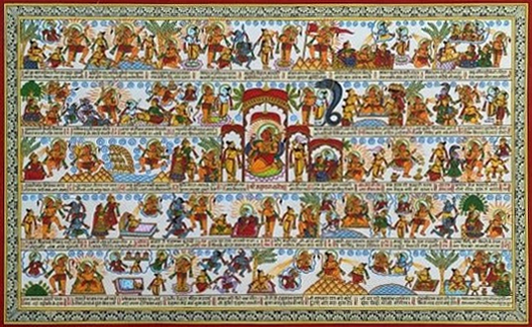Phad art is a style of traditional folk painting, practiced in the state of Rajasthan, India. Known for its vivid colors and intricate details, Phad paintings serve as visual narratives that depict stories from epics, folklore, and religious texts. The term ‘Phad’ refers to the large scrolls or banners on which these stories are painted. Traditionally, it is not made for art sake, but to serve as ‘portable temples’ to the deities of the Rebari tribe.
History and Tradition
The origins of Phad painting can be traced back over 700 years ago to the Joshi family in Shahpura and Bhilwara, Rajasthan. However, the artists in the family believe that this art form has existed for a hundred thousand years. This folk art form is primarily associated with the Rebari tribe and Bhopas (priests in the tribe) follow the tradition of traveling and singing about the epics painted in the Phad, from village to village.
The tradition of Phad painting is largely centered around the stories of Pabuji and Devnarayan, revered deities in Rajasthan's local folklore. The scrolls were used by the Bhopas during religious ceremonies and community gatherings, where they would unroll the Phad and narrate the stories, often accompanied by music and song.
Technique and Details
Phad painting involves a meticulous process, starting from scrolls made from hand-woven cotton fabric, which is first soaked overnight and then stretched on a wooden frame. The fabric is then treated with a mixture of rice paste and gum to create a smooth, durable surface for painting. The drawings are done using charcoal or a light pencil and then colored with natural vegetable dyes.
The stories depicted in Phad paintings usually revolve around heroic tales, divine exploits, and legendary feats. Characters are portrayed with expressive facial features and dynamic poses. However, the scenes are not linear or chronological and work on the principles of ‘horror vacui’. The protagonist looms over the composition and place gets primacy over time. The colors used in Phad paintings also have symbolic meaning—red for valor and strength, green for nature and life, yellow for knowledge, and blue for divinity. Artists often work collaboratively, with one person sketching the outlines and others filling in the colors and details.
FAQs
Do you offer custom Phad art pieces?
We work with artists who can create custom Phad art pieces tailored to your preferences. If you are interested in commissioning a personalized Phad painting, please contact our customer service team for more details.
Can I learn more about the history and significance of Phad art?
Yes, our platform provides detailed information about the history, cultural significance, and techniques of Phad art. You can explore our blog section or product descriptions to learn more about this traditional art form and its role in Rajasthani culture.
Is Phad art suitable for gifting?
Yes, Phad art makes a unique and meaningful gift, particularly for those who appreciate traditional Indian crafts and storytelling. It is ideal for special occasions, such as weddings, anniversaries, or housewarmings, offering both artistic beauty and cultural significance.
Show Less



























































